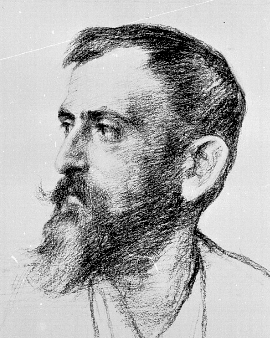Otto Ubbelohde is the son of a lawyer and professor and was born in Marburg. At the age of 18 he is admitted to the Academy in Munich and is able to begin his art studies, finishing them with a special distinction as a portraitist and starting his career as a freelance painter and draughtsman. His teachers included greats such as the Austrian painter Gabriel von Hackl and the German Ludwig von Löfftz.
In Munich he joins the Luitpold Group of visual artists, which is committed to artistic quality; and he has contact with the artists' colony of Dachau and Worpswede. Together with the Swiss graphic artist Carl Theodor Meyer he creates a portfolio of etchings and Ubbelohde's passion for etching. He marries his cousin Hanna Unger and is co-founder of the Vereinigte Werkstätten für Kunst im Handwerk in Munich until he moves his residence to Goßfelden in Hesse. Around 1900 he begins to illustrate for the Brothers Grimm and their work "Kinder- und Hausmärchen" ("Children's and Household Tales"). He also illustrates the Hesse Art Calendar (in the following years he will illustrate eight more calendars). Until 1909 he worked on the Grimm fairy tales and illustrated their anniversary edition, among other things. He is said to have made more than 450 pen-and-ink drawings in all, and the landscapes and costumes are strongly oriented towards Hesse - Hessian costumes, buildings and cultural sites can be found. In 1913 he had his first solo exhibition in Giessen at the age of 46, where etchings and oil paintings were exhibited. On his 50th birthday he is awarded the honorary title of professor by the University of Giessen. In the following years he worked on a book with a collection of all his etchings, undertook study trips and illustrated city guides and posters. He dies of cancer in Goßfelden in his home.
In addition to his paintings, his drawings, illustrations and etchings in particular gained great renown - for books, calendars, postcards and travel guides. Perhaps best known is his work on the works of the Grimm brothers, who made Ubbelohde one of the most famous German fairy tale illustrators. Today the original Grimm illustrations are mainly to be found in Japan. Although Ubbelohde's work seemed to have been forgotten for a time, he has succeeded in bringing his skills back into the limelight. Scientific monographs have been written about him, a cultural prize named after him has been awarded annually since 1987, and streets and schools bear his name. His house and studio in Goßfelden is now a listed building, research centre and museum. It is inhabited by his grandniece, since 1999 exhibitions have been held there. His estate amounts to about 3000 sketches and paintings.
×





.jpg)
.jpg)
.jpg)
.jpg)
.jpg)
.jpg)
.jpg)
.jpg)
.jpg)
.jpg)
.jpg)
.jpg)
.jpg)
.jpg)
_-_(MeisterDrucke-1129965).jpg)
_-_(MeisterDrucke-1129965).jpg)
.jpg)
.jpg)
.jpg)
.jpg)
.jpg)
.jpg)
.jpg)
.jpg)
.jpg)
.jpg)
_-_(MeisterDrucke-692453).jpg)
_-_(MeisterDrucke-692453).jpg)
.jpg)
.jpg)
_-_(MeisterDrucke-692501).jpg)
_-_(MeisterDrucke-692501).jpg)
.jpg)
.jpg)
_-_(MeisterDrucke-689716).jpg)
_-_(MeisterDrucke-689716).jpg)
.jpg)
.jpg)
.jpg)
.jpg)
.jpg)
.jpg)
.jpg)
.jpg)
.jpg)
.jpg)
.jpg)
.jpg)
.jpg)
.jpg)
.jpg)
.jpg)
.jpg)
.jpg)
.jpg)
.jpg)
.jpg)
.jpg)
.jpg)
.jpg)
.jpg)
.jpg)
.jpg)
.jpg)
.jpg)
.jpg)
.jpg)
.jpg)
.jpg)
.jpg)
.jpg)
.jpg)
.jpg)
.jpg)
.jpg)
.jpg)
.jpg)
.jpg)
.jpg)
.jpg)
.jpg)
.jpg)






